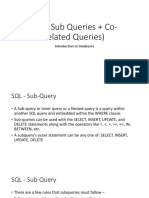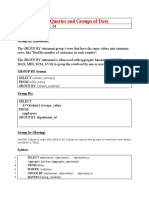Lab 5: Subqueries
The learning objectives of this lab are to
• Learn how to use subqueries to extract rows from processed data
• Select the most suitable subquery format
• Use correlated subqueries
• SQL Query order of execution
First let’s outline the basic characteristics of a subquery.
• A subquery is a query (SELECT statement) inside a query
• A subquery is normally expressed inside parentheses
• The first query in the SQL statement is known as the outer query
• The query inside the SQL statement is known as the inner query
• The inner query is executed first
• The output of an inner query is used as the input for the outer query
• The entire SQL statement is sometimes referred to as a nested query
A subquery can return one value or multiple values. To be precise, the subquery can
return:
• One single value (one column and one row). This subquery is used anywhere
a single value is expected, as in the right side of a comparison expression.
Obviously, when you assign a value to an attribute, that value is a single
value, not a list of values. Therefore, the subquery must return only one value
1
(One column, one row). If the query returns multiple values, the DBMS
will generate an error.
• A list of values (one column and multiple rows). This type of subquery is
used anywhere a list of values is expected, such as when using the IN clause.
This type of subquery is used frequently in combination with the IN operator
in a WHERE conditional expression.
• A virtual table (multicolumn, multirow set of values). This type of
subquery can be used anywhere a table is expected, such as when using the
FROM clause.
It’s important to note that a subquery can return no values at all; it is a NULL. In such
cases, the output of the outer query may result in an error or a null empty set depending
where the subquery is used (in a comparison, an expression, or a table set).
In the following sections, you will learn how to write subqueries within the SELECT
statement to retrieve data from the database.
5.1 SELECT Subqueries
The most common type of subquery uses an inner SELECT subquery on the right side of
a WHERE comparison expression. For example, to find the prices of all tickets with a
price greater than or equal to the average ticket price, you write the following query:
2
SELECT TICKET_NO, TICKET_TYPE, TICKET_PRICE
FROM TICKET
WHERE TICKET_PRICE >= (SELECT AVG(TICKET_PRICE) FROM TICKET);
The output of the query is shown in Figure 69.
Figure 69 Example of SELECT Subquery
Note that this type of query, when used in a >, <, =, >=, or <= conditional expression,
requires a subquery that returns only one single value (one column, one row). The value
generated by the subquery must be of a “comparable” data type; if the attribute to the left of
the comparison symbol is a character type, the subquery must return a character string. Also,
if the query returns more than a single value, the DBMS will generate an error.
5.2 IN Subqueries
The following query displays all employees who work in a Theme Park that has the word
‘Fairy’ in its name. As there are a number of different Theme Parks that match this
3
criteria you need to compare the PARK_CODE not to one park code (single value), but to
a list of park codes. When you want to compare a single attribute to a list of values, you
use the IN operator. When the PARK_CODE values are not known beforehand but they
can be derived using a query, you must use an IN subquery. The following example lists
all employees who have worked in such a Theme Park.
SELECT DISTINCT EMP_NUM, EMP_LNAME, EMP_FNAME, PARK_NAME
FROM EMPLOYEE NATURAL JOIN HOURS NATURAL JOIN
ATTRACTION NATURAL JOIN THEMEPARK
WHERE PARK_CODE IN (SELECT THEMEPARK.PARK_CODE FROM
THEMEPARK WHERE PARK_NAME LIKE ‘%Fairy%’);
The result of that query is shown in Figure 71.
Figure 71 Employees who work in a Theme Park LIKE ‘Fairy’.
Task 5.1 Enter and execute the above query and compare your output with that shown in
Figure 71.
4
5.3 HAVING Subqueries
A subquery can also be used with a HAVING clause. Remember that the HAVING
clause is used to restrict the output of a GROUP BY query by applying a
conditional criteria to the grouped rows. For example, to list all PARK_CODEs
where the total quantity of tickets sold is greater than the average quantity sold, you
would write the following query:
SELECT PARK_CODE, SUM(LINE_QTY)
FROM SALES_LINE NATURAL JOIN TICKET
GROUP BY PARK_CODE
HAVING SUM(LINE_QTY) > (SELECT AVG(LINE_QTY) FROM SALES_LINE);
The result of that query is shown in Figure 72.
Figure 72 PARK_CODES where tickets are selling above average.
Task 5.2 Using the query above as a guide, write a new query to display the first and last
names of all employees who have worked in total greater that the average number of
5
hours in total during May 2007. Your output should match that shown in Figure 73.
Figure 73 Output for task 5.2
Using Group by on Multiple Columns
Group by x means put all those with the same value for X in the one group).
Group By x, y means put all those with the same values for both X and Y in the one
group.
To illustrate using an example, let's say we have the following table, to do with who is
attending what subject at a university:
When you use a group by on the subject column only; say:
You will get something like:
6
Because there are 5 entries for ITB001, and 2 for MKB114
This is because, when we group by two columns, it is saying "Group them so that all of
those with the same Subject and Semester are in the same group, and then calculate all the
aggregate functions (Count, Sum, Average, etc.) for each of those groups". In this example,
this is demonstrated by the fact that, when we count them, there are three people doing ITB001
in semester 1, and two doing it in semester 2. Both of the people doing MKB114 are in semester
1, so there is no row for semester 2 (no data fits into the group "MKB114, Semester 2")
5.4 Multirow Subquery operator ALL.
So far, you have learned that you must use an IN subquery when you need to compare a
value to a list of values. But the IN subquery uses an equality operator; that is, it selects
only those rows that match (are equal to) at least one of the values in the list. What
happens if you need to do an inequality comparison (> or <) of one value to a list of
values? For example, to find the ticket_numbers and corresponding park_codes of the
7
tickets that are priced higher than the highest-priced ‘Child’ ticket you could write the
following query.
SELECT TICKET_NO, PARK_CODE, TICKET_PRICE
FROM TICKET
WHERE TICKET_PRICE > ALL (SELECT TICKET_PRICE FROM TICKET
WHERE TICKET_TYPE = 'CHILD');
The output of that query is shown in Figure 74.
Figure 74 Example of ALL.
This query is a typical example of a nested query. The use of the ALL operator allows
you to compare a single value (TICKET_PRICE) with a list of values returned by the
nested query, using a comparison operator other than equals. For a row to appear in
the result set, it has to meet the criterion TICKET_PRICE > ALL of the individual
values returned by the nested query.
8
5.5 Attribute list Subqueries
The SELECT statement uses the attribute list to indicate what columns to project in the
resulting set. Those columns can be attributes of base tables or computed attributes or the
result of an aggregate function. The attribute list can also include a subquery expression,
also known as an inline subquery. A subquery in the attribute list must return one single
value; otherwise, an error code is raised. For example, a simple inline query can be used
to list the difference between each tickets’ price and the average ticket price:
SELECT TICKET_NO, TICKET_PRICE,
(SELECT AVG(TICKET_PRICE) FROM TICKET) AS AVGPRICE,
TICKET_PRICE - (SELECT AVG(TICKET_PRICE) FROM TICKET) AS DIFF
FROM TICKET;
The output for this query is shown in Figure 75.
9
Figure 75 Displaying the difference in ticket prices.
This inline query output returns one single value (the average ticket’s price) and that the
value is the same in every row. Note also that the query used the full expression instead of
the column aliases when computing the difference. In fact, if you try to use the alias in the
difference expression, you will get an error message. The column alias cannot be used in
computations in the attribute list when the alias is defined in the same attribute list.
5.6 Correlated Subqueries
A correlated subquery is a subquery that executes once for each row in the outer query.
The relational DBMS uses the same sequence to produce correlated subquery results:
1. It initiates the outer query.
2. For each row of the outer query result set, it executes the inner query by passing
the outer row to the inner query.
That process is the opposite of the subqueries you have seen so far. The query is called a
correlated subquery because the inner query is related to the outer query because the
inner query references a column of the outer subquery. For example, suppose you want
to know all the ticket sales in which the quantity sold value is greater than the average
quantity sold value for that ticket (as opposed to the average for all tickets). The
following correlated query completes the preceding two-step process:
SELECT TRANSACTION_NO, LINE_NO, LINE_QTY, LINE_PRICE
FROM SALES_LINE SL
10
WHERE SL.LINE_QTY > (SELECT AVG(LINE_QTY)
FROM SALES_LINE SA
WHERE SA. TRANSACTION_NO = SL. TRANSACTION_NO);
Figure 76 Example of a correlated subquery
As you examine the output shown in figure 76, note that the SALES_LINE table is
used more than once; so you must use table aliases.
Correlated subqueries can also be used with the EXISTS special operator. For example,
suppose you want to know all the names of all Theme Parks where tickets have been
recently sold. In that case, you could use a correlated subquery as follows:
SELECT PARK_CODE, PARK_NAME, PARK_COUNTRY
FROM THEMEPARK
WHERE EXISTS (SELECT PARK_CODE FROM SALES
WHERE SALES.PARK_CODE = THEMEPARK.PARK_CODE);
11
The output for this query is shown in figure 77.
Figure 77 Example of correlated subqueries
5.7 SQL Query order of execution
The SQL order of execution defines the order in which the clauses of a query are evaluated.
Some of the most common query challenges people run into could be easily avoided with a
clearer understanding of the SQL order of execution, sometimes called the SQL order of
operations. Understanding SQL query order can help you diagnose why a query won’t run, and
even more frequently will help you optimize your queries to run faster.
12
This order is:
1. FROM and JOINs
The FROM clause, and subsequent JOINs are first executed to determine the total working set of
data that is being queried. This includes subqueries in this clause, and can cause temporary tables
to be created under the hood containing all the columns and rows of the tables being joined.
2. WHERE
Once we have the total working set of data, the first-pass WHERE constraints are applied to the
individual rows, and rows that do not satisfy the constraint are discarded. Each of the constraints
can only access columns directly from the tables requested in the FROM clause. Aliases in the
SELECT part of the query are not accessible in most databases since they may include
expressions dependent on parts of the query that have not yet executed.
3. GROUP BY
The remaining rows after the WHERE constraints are applied are then grouped based on
common values in the column specified in the GROUP BY clause. As a result of the grouping,
there will only be as many rows as there are unique values in that column. Implicitly, this means
that you should only need to use this when you have aggregate functions in your query.
4. HAVING
If the query has a GROUP BY clause, then the constraints in the HAVING clause are then
applied to the grouped rows, discard the grouped rows that don't satisfy the constraint. Like the
WHERE clause, aliases are also not accessible from this step in most databases.
5. SELECT
Any expressions in the SELECT part of the query are finally computed.
6. ORDER BY
If an order is specified by the ORDER BY clause, the rows are then sorted by the specified data
in either ascending or descending order. Since all the expressions in the SELECT part of the
query have been computed, you can reference aliases in this clause.
7. LIMIT / OFFSET
Finally, the rows that fall outside the range specified by the LIMIT and OFFSET are discarded,
leaving the final set of rows to be returned from the query.
13
Exercises
E 5.1 Write a query that displays the first name, last name of all employees who earn
more than the average hourly rate. Do not display duplicate rows. Your output should
match that shown in Figure E-5.1.
Figure 70 Output for E-5.1
E.5.2 Write a query to display an employee’s first name, last name and date worked
which lists the difference between the number of hours an employee has worked on an
attraction and the average hours worked on that attraction. Label this column
‘DIFFERENCE’ and the average hours column ‘AVERAGE’.
E 5.3 Type in and execute the two correlated subqueries in section 5.6 and check
your output against that shown in figures 76 and 77.
E 5.4 Modify the second query you entered in E 5.3 to display all the theme parks
where there have been no recorded tickets sales recently.
E 5.5 Write a query to find the attract capacity, with a attract capacity less than or equal
to the average attract capacity.
14
References:
https://www.sisense.com/blog/sql-query-order-of-operations/
https://sqlbolt.com/lesson/select_queries_order_of_execution
15

























































































